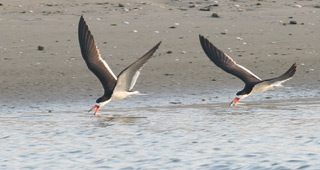CR 650, Ocean Drive, Middle Twp, NJ
NJ Department of Environmental Protection
Turn Right out of the Lighthouse parking lot onto Central Ave. Follow the road around the bend to the left, onto Spruce Ave. Follow Spruce Ave., which becomes Route 147 and travel over one causeway. Turn Right onto Ocean Dr. and pay toll on Grassy Sound Bridge. (The toll is $1 from May–October; otherwise the bridge is free.) Continue over the bridge, and once on land you have reached Nummy Island. Any point on this stretch of road is good for
stopping and viewing. Map
 |
| Black Skimmers | Michael Lyncheski |
| |
| | Nummy Island is a large
undeveloped salt marsh between the Stone Harbor free bridge to the north and the Grassy Sound toll bridge to the south. It is excellent for shorebirds, marsh birds, and wading birds,
especially in spring, summer and fall. It is best at high tide when the shorebirds rest and forage in and around the salt ponds on both sides of the road. Over the years Snowy Owl, Short-eared Owl, Marbled Godwit, Peregrine Falcon, and even Long-billed Curlew have been visitors to this island. You can also look across the inlet to often inaccessible parts of Stone Harbor Point.
the cedar grove near the base of the Stone Harbor free bridge, where Yellow-crowned Night-Herons, a threatened species in New Jersey, often roost. They can also be found
foraging along the salt ponds in the mornings
and evenings in spring and summer. Close views of feeding Black Skimmers from the nearby Stone Harbor Point breeding colony are always a treat in summer.
American Oystercatcher, Marbled
Godwit, and Black-bellied Plover are on the island. Red-throated and Common Loon are in the channels, along with Horned Grebe.
Seasonally resident egrets, herons and Clapper Rails are setting up nesting territories while migrant sandpipers, such as Dunlin, Ruddy Turnstone, Sanderling, Short-billed Dowitcher, Red Knot and Semipalmated Plover are easily observed as they feed on the mudflats. Many of these birds leave in late May and June for their breeding grounds in the north.
Nummy Island, like all salt marsh habitats in New Jersey, is notorious for biting insects in summer. Although there are many birds to see including Willet, Seaside Sparrow, Boat-tailed Grackle and thousands of nesting Laughing Gull, you may want to observe from the car and keep the windows closed.
Fall is a great time to scan the salt marsh. Looking west toward the mainland, tidal pools may be filled with migrant shorebirds and
lingering gulls. Looking eastward, the last Ospreys sail over the open water while small flocks of Brown Pelicans move up the coast in their post-breeding wanderings.
|